Recent Articles
Popular Makes
Body Types
2018 Volkswagen Atlas Road Test and Review
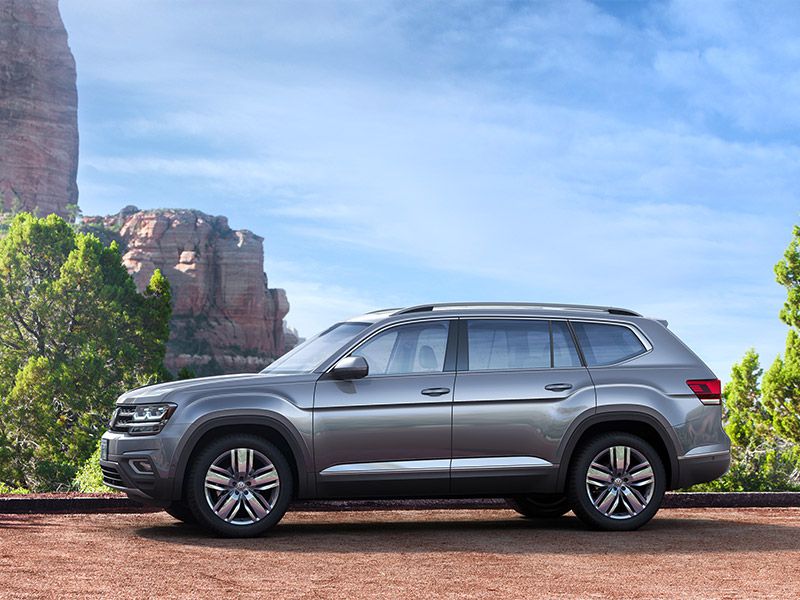
2018 Volkswagen Atlas exterior profile ・ Photo by Volkswagen
Atlas is a name that traces its origins to Greek mythology, the rebellious Titan sentenced by Zeus (the boss god in the Greek pantheon) to carry the universe on his shoulders for a long time—eternity, in fact. A big job by any reckoning, and thus a fitting name for this big-job SUV, in fact the biggest Volkswagen ever. With seating for six or seven passengers and dimensions that make those seating positions roomy enough for adults, the Atlas gives Volkswagen something it’s needed for quite some time—a crossover ute with three rows of seats. Never mind that it’s yet another player in a crowded game. Better late than never definitely applies here. So the question is: What does the Atlas offer that the makes it stand out in the herd? We went to Texas for a first drive to address that question. But before we get behind the wheel, let’s get acquainted.
Haven’t we met?
If you’ve paid attention to the auto shows, the Atlas probably looks familiar. It made its official debut at last November’s Los Angeles auto show and has dominated subsequent VW displays at the Detroit, Chicago, and New York shows in the 2017 calendar year. But its development history goes back much further, to the Cross Blue concept unveiled at the 2013 North American International Auto Show in Detroit.
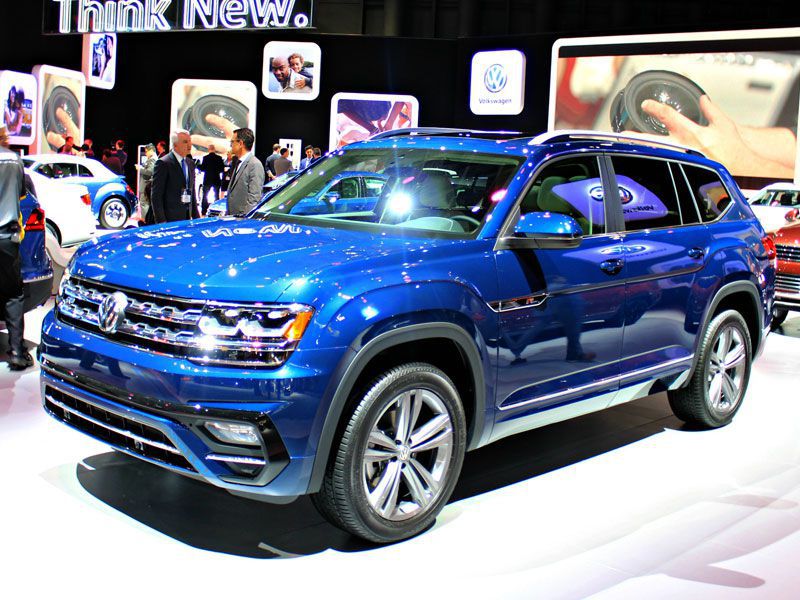
Photo by Matt Carpenter
Dimensional Definition
The biggest-ever Volkswagen doesn’t mean the biggest SUV. Far from it. VW defines the Atlas as a “big midsize sport-utility.” Market-wise, that pits it against a formidable array of established competitors: Buick Enclave, Chevy Traverse, GMC Acadia, Ford Explorer, Honda Pilot, Hyundai Santa Fe, Mazda CX-9, Nissan Pathfinder, and Toyota Highlander. And there are more. So vehicles in this category are midsize only in contrast to the real big boys, Chevy Tahoe and Suburban, Ford Expedition, etc. At 198.3 inches long on a 117.3-inch wheelbase, the Atlas falls more or less into the upper middle of its competitive set.
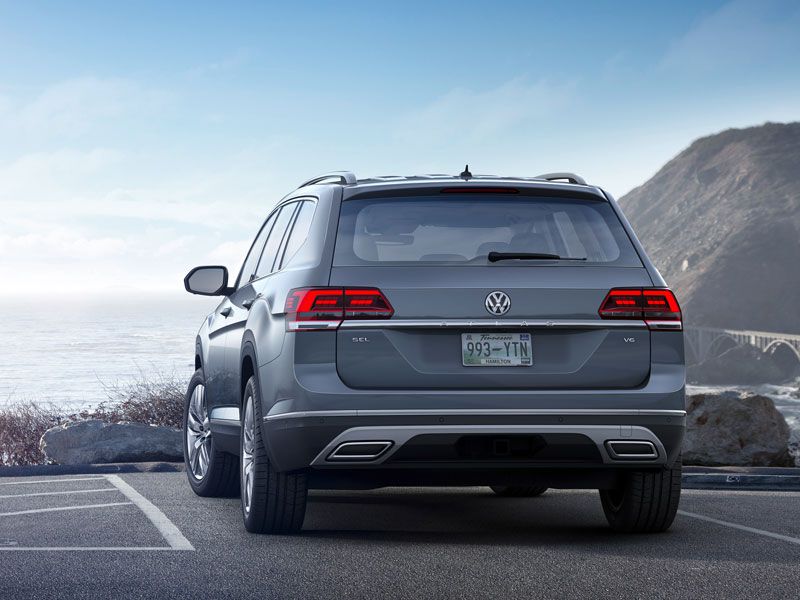
Photo by Volkswagen
Structural DNA
The underpinnings of the Atlas—Volkswagen’s versatile front-drive MQB architecture—are common to several vehicles, including the entire Golf and Jetta families. The Atlas is considerably bigger, of course, but the structural rigidity that distinguishes the smaller Volkswagens seems to have been sustained in this largest-ever application. That’s true even though the 4500-pound Atlas outweighs anything else in the MQB family by several hundred pounds. Also worth noting: the Atlas shares nothing with the Audi Q7. The Atlas engines mount transversely, whereas the Q7’s are longitudinal, ie, fore and aft, which makes a big difference in terms of underlying structure.
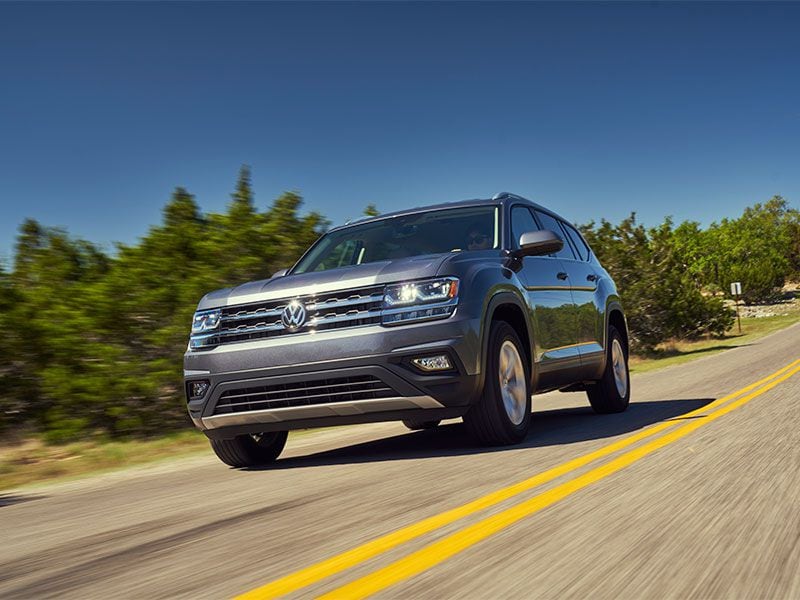
Photo by Volkswagen
Powertrain Options
There are two engine choices, both proven members of VW’s powertrain inventory. The standard engine is a 2.0-liter turbocharged 4-cylinder, rated for 235 horsepower,258 pound-feet of torque, and limited to front-drive. Additional thrust (and the option of VW’s 4Motion all-wheel drive system) is available via VW’s unique 3.6-liter VR6, a narrow angle V6 (15 degrees) with a common cylinder head for the two banks—276 hp, 266 lb-ft. Both engines are paired with an 8-speed automatic, which has an agreeably prompt response to manual shifting, though it can only be achieved with the lever in “S” mode (no shift paddles). The 4Motion system includes multiple drive modes—Snow, On-road, Off-road, and Sport. Acceleration with the VR6 is respectable, but probably won’t test out as best-in-class, and we’ll have to wait and see how the 2.0-liter deals with two-plus tons of SUV.
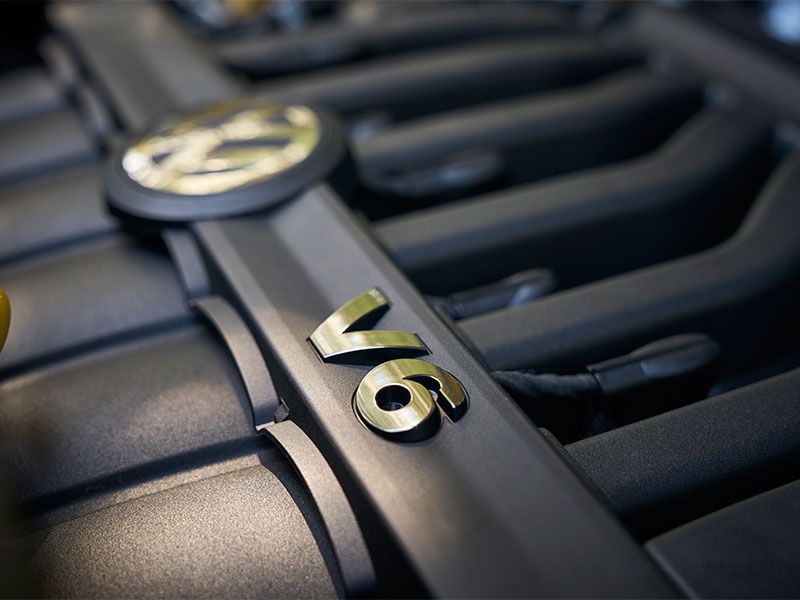
Photo by Volkswagen
Eyes on Design
Instilling visual character and distinction in a two-box design—small box embracing the engine compartment, big box for the passenger/cargo compartment—is always a challenge, but the cosmetics team has managed to give the Atlas a look of its own. The front fascia is faithful to current VW styling, but the key elements are the sculpted hood and strong character line that flows along the sides and defines the wheel wells. VW has followed the industry trend, pioneered by Ford, of a hands-free power rear hatch (five trims), and the roof rack is ready for camping gear, canoes, mountain bikes, etc. Of course, like other vehicles in this size class, securing roof loads usually requires a small step ladder or the help of an NBA player.
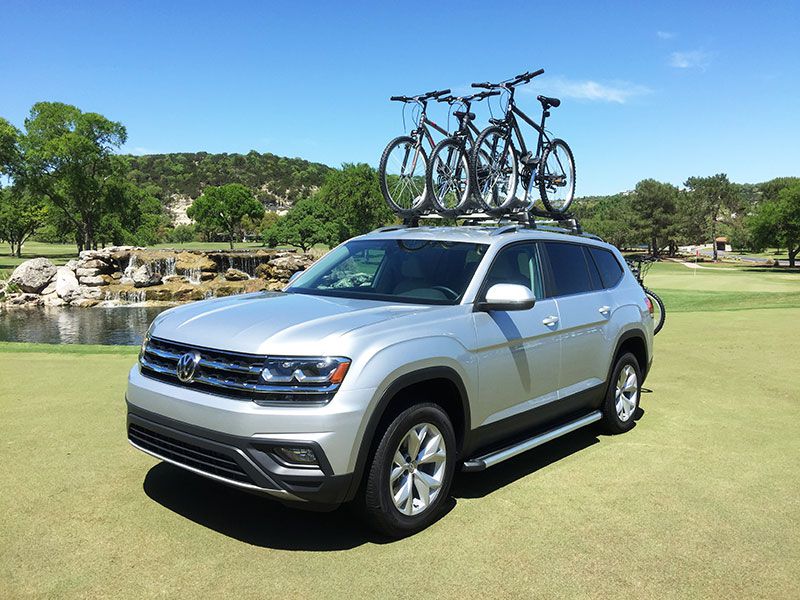
Photo by Tony Swan
Inside Atlas
While its exterior dimensions are unexceptional, the Atlas gets high marks for roominess. The design team has engineered interior space worthy of competing with a Honda. In lower trims, it seats seven, but a six-seat configuration is available, with captain’s chairs in the middle row, which adjusts up to 7.7 inches fore and aft. Lots of stretch-out space there, and adults can actually travel with a reasonable degree of comfort in the rearmost perch. The front buckets have sporty thigh and torso bolsters, good support without being too snug; most interior surfaces are reasonably soft to the touch; there’s a big bin center console; and the center dash of our primary Texas tester was dominated by a big 8-inch touchscreen featuring the second generation of VW’s MIB infotainment/telematics system. Among the features in our top-of-the-line ride was a nav system that proved to be a little capricious with programmed destinations, an idiosyncrasy reported in some of the other test vehicles. VW will undoubtedly have this sorted when the Atlas reaches showrooms.

Photo by Volkswagen
Zigs, zags, and zeitgeist.
Thanks to above average structural solidity and well-chosen spring and shock absorber rates, the Atlas retains most of the athletic feel that distinguishes its smaller cousins from the Golf family. Ride quality strikes an agreeable balance between firm and compliant, and transient responses—quick back and forth maneuvers—seem to compare favorably with the best of the class competitors, e.g., the Mazda CX-9. There’s some up and down motion on bumpy stretches, which is not uncommon for vehicles with high centers of gravity and substantial ground clearance—in this case, 8 inches—but tire adhesion (aka grip) builds confidence, and we’d expect brisk responses in emergency maneuvers. If there’s any dynamic element that feels a bit below par it’s the steering, over-assisted at low speeds and lacking on-center tactility. Still, the Atlas delivers the feel and response that distinguish vehicles with Teutonic heritage.
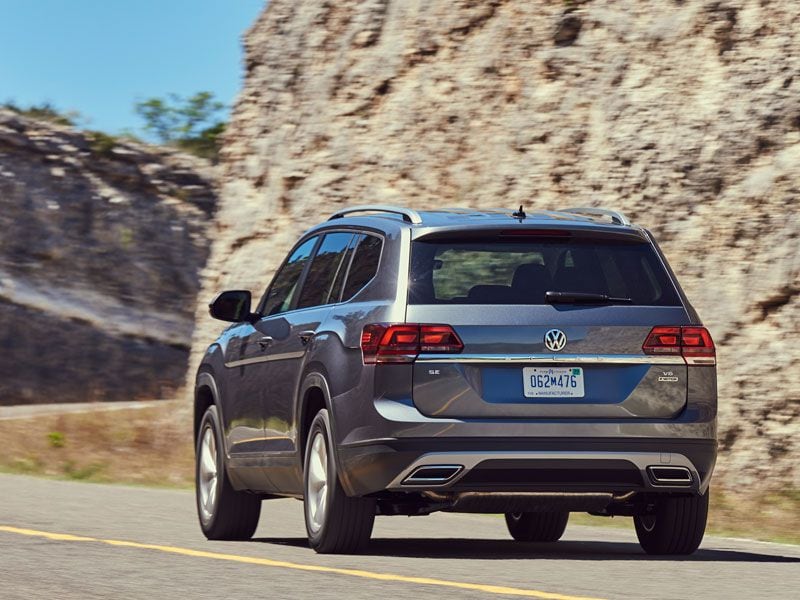
Photo by Volkswagen
Made In the USA
While the design and engineering are distinctly Teutonic, the Atlas was designed specifically for the U.S. market, and its North American flavor will be rooted in the lower 48. Assembly will take place alongside the Passat sedan at Volkswagen’s plant in Chattanooga, Tennessee.
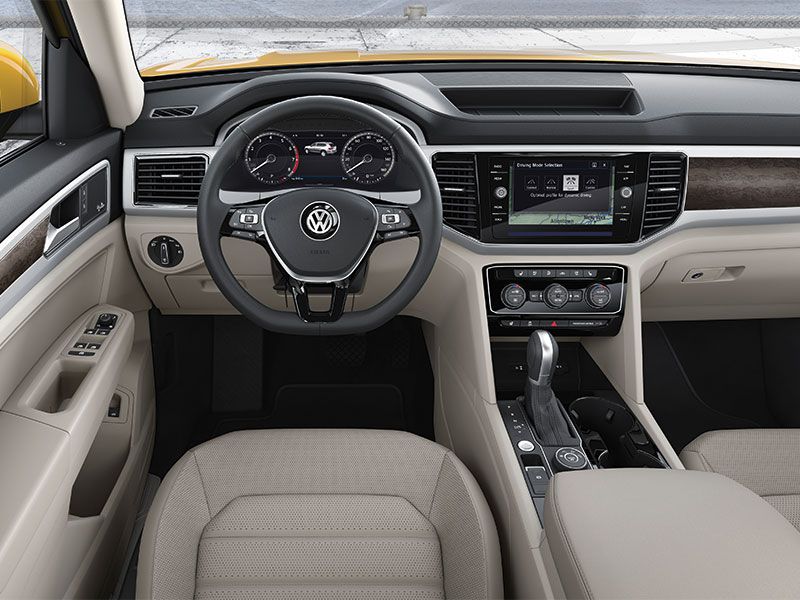
Photo by Volkswagen
Pricing
The ground floor of the Atlas pricing elevator is the 4-cylinder front-drive S at $31,425, and there are numerous stops en route to the fifth floor, the residence of the SEL Premium. After the S, comes the S Launch Edition, a limited edition that includes the VR6 engine, at $34,425, plus the option of all-wheel drive for an additional $1000. Moving up, there’s the SE ($34,515), the SE With Technology ($36,615), SEL ($40,085), and the SEL Premium ($49,415). All but the S Launch Edition and SEL Premium come with the 4-cylinder engine. Add about $1800 for VR6 power in the others. Similarly, all-wheel adds $1800 to most trims, with the exception of the S Launch ($1000) and the SEL Premium, where it’s standard. Stand-alone options include second-row captain’s chairs for all but the S model, at $625; 20-inch black-anodized wheels ($995 SEL, $235 SEL Premium); and VW’s R-Line sport appearance package (SE and SEL), $1960.
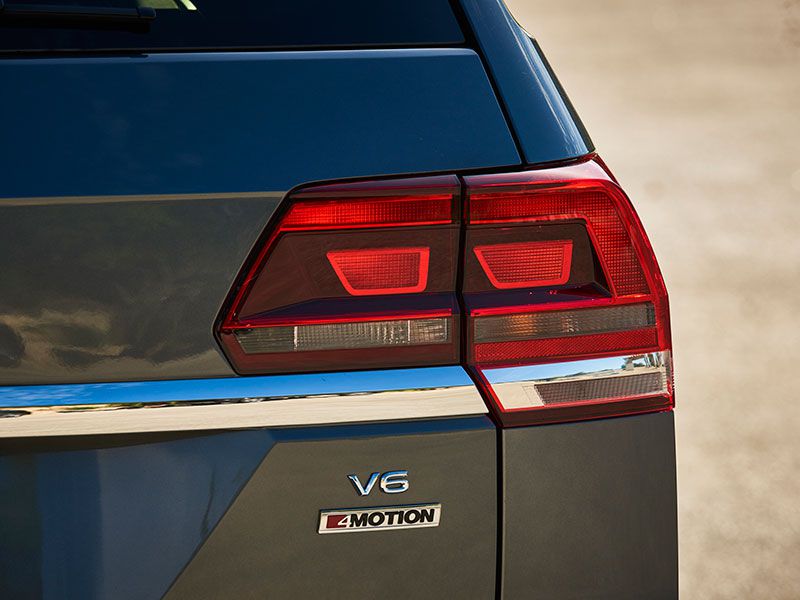
Photo by Volkswagen
Final Word
VW, while coming into the 3-row SUV segment when it's already hot, has delivered its largest SUV to date and that is not only an accomplishment for the brand, but should generally make its competition nervous.
This roomy new seven-seater has elements of appeal that stand out from the herd: solid construction; distinctive styling with a masculine flavor; dynamics with a higher-than-average fun-to-drive index; and competitive pricing.
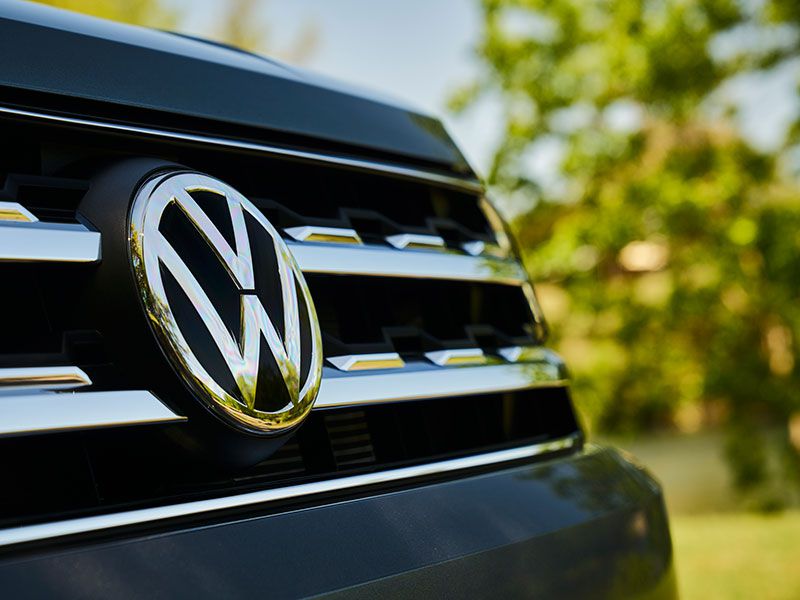
Photo by Volkswagen